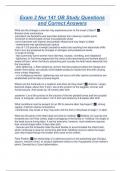Exam (elaborations)
Exam 2 Nur 141 OB Study Questions and Correct Answers
- Course
- Institution
What are the changes a woman may experience prior to the onset of labor? - Braxton hicks contractions -persistent low backache and sacroiliac distress from relaxing of pelvic joints -brownish or blood tinged cirvical mucus(bloody show) -cervix becomes soft (ripens) and partially effaced and may beg...
[Show more]



